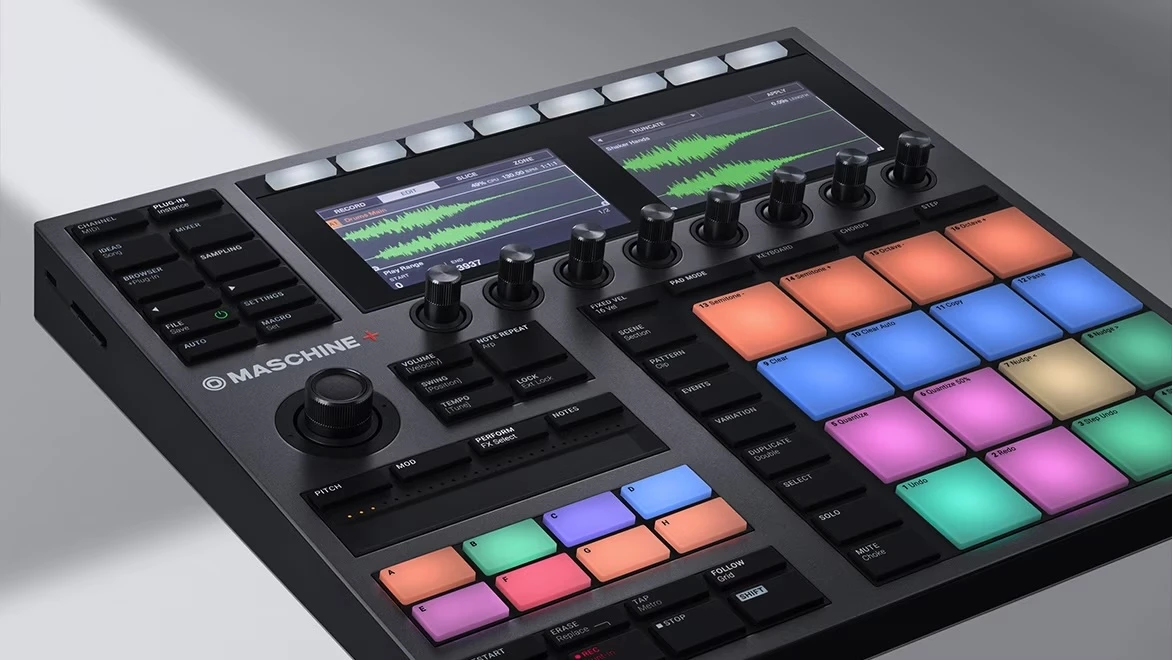& Construction

Integrated BIM tools, including Revit, AutoCAD, and Civil 3D
& Manufacturing

Professional CAD/CAM tools built on Inventor and AutoCAD
Native Instruments is a leading manufacturer of successful hardware and software products for music production—including the Traktor, Komplete, and Maschine product ranges. As the complexity and diversity of its products constantly increases, so too does the need for product data such as parts lists and production documents. At the same time, many different companies need to be involved in processes from development to manufacturing and after-sales. Native Instruments therefore set itself the goal of providing the necessary product and process data centrally and in real time worldwide, so it could react quickly and efficiently to market dynamics and increasing cost pressure.
The company settled on Autodesk’s Fusion 360 Manage as the right solution for the simple and agile provision of product data and control of manufacturing processes. Jan Dreßler, Senior Hardware Manager, spoke to us about the original objective, the successes to date, plans for the future, and insights for anyone looking to introduce a cross-company solution for managing product data and processes.
Like many companies, Native Instruments is confronted with ever more demanding customer requirements. Custom state-of-the-art products that offer a good cost-benefit ratio are highly sought-after worldwide. In contrast, the costs, lead times, and risks that manufacturers and suppliers face are all increasing. Geopolitical changes are constantly creating additional, unpredictable areas of tension and leading to bottlenecks in component supply. A rapid and sustained response to changing market conditions is crucial to success. This requires error- and loss-free communication and coordination of manufacturing operations that are distributed across several continents.
That in turn calls for lean and agile processes with connected, efficient data management. Before rolling out Fusion 360 Manage, Native Instruments was using an open source solution that was satisfactory only in some areas, no longer met today’s market requirements, wasn’t user-friendly enough, and could only be used in-house. Time and again, information gaps would make themselves felt. Incomplete or outdated parts lists, users resorting to countless Excel spreadsheets, an inadequate revision system, and manual data preparation repeatedly led to inconsistencies.
Communication with the company’s globally distributed third-party manufacturers was particularly susceptible, as production data was exchanged manually, making it only partially traceable. On top of that, suppliers weren’t integrated into the release and change processes, and it was impossible to know which version was currently in production. This made reliable planning and implementation of changes almost impossible.
Six years ago, the search for a solution quickly led the team to Fusion 360 Manage. In its standard configuration, the cloud-based solution made it possible to immediately record and provide constantly changing production data centrally. The key reasons for choosing a cloud solution included making local installation unnecessary and ensuring global availability. Thanks to its integrated release processes, Fusion 360 Manage can document revisions and distribute them in a traceable manner. At the same time, the system is proving to be very adaptable, which means it also offers the option of future expansions. As a result, it provides the sought-after bridge between development, suppliers, and the production line, establishing standardized processes among the parties involved.
Above all, its ease of use soon proved compelling: “The tool’s graphical interface is easy to use and provides access to all the data sheets and relevant documents for each part,” Dreßler says. System take-up can be expanded quickly since familiarization takes only a short time, and Native Instruments’ suppliers recognize that the direct access it affords them is an advantage they are keen to use.
Today, the system manages all current hardware products and their production-relevant data such as drawings, parts lists (mechanics, electronics, software, packaging, etc.), modules, alternative components, process instructions, quality documentation, test cases, and much more. It also records procurement data so as to provide a constantly updated cost overview at the product and component level. That includes alternative sources of supply and delivery conditions. As part of preparations for manufacturing, it also records data on prototypes and samples for incorporation into an assessment and to ensure that deadlines are met.
This is all governed by a digitally mapped change management system, which enables the smooth and automated exchange of information—without the additional work and associated errors that were previously commonplace. Implementation of all changes (item change orders) and any resulting necessary adjustments is coordinated and documented centrally, including the change history. These approval processes were modeled according to Native Instruments’ own requirements and offer the necessary flexibility for single- or multi-stage releases. Most importantly, however, these processes immediately notify the production line by means of standardized, automatically sent emails following release.
— Jan Dreßler, Senior Hardware Manager, Native Instruments
Native Instruments has been using Fusion 360 Manage for its supply chain management for over six years now. Today, the software is a natural part of day-to-day development and manufacturing work. Its implementation led to a fundamental realignment of how the company collaborates with its contract manufacturers abroad. These now work with the same data in real time and are an integral part of Native Instruments’ processes. They no longer accept changes outside PLM for current orders. Since PLM also coordinates production changes (silent running changes or immediate changes), the system demonstrably adds value for both sides.
And it’s not a one-way street: supplier data is maintained directly in the system, thus avoiding unnecessary reconciliation and transmission errors relating, say, to parts suppliers’ part numbers. The fact that this data is now stored in the system enables manufacturers to quickly compare it with their own in-house procurement—turning two or three days of manual work into just three clicks. Manufacturers can also make suggestions if components are either not available or available as a cheaper alternative. These are evaluated via PLM, validated via samples, and finally released and introduced.
Data security and access control play a decisive role here. All users are assigned the necessary roles via groups, which grant them the corresponding minimum required access rights. Each in-house and third-party participant can access only what they need for their tasks.
In the constant search for more cost-effective components with better availability, PLM supports cost-down activities in a similar way. These new processes also include quality assurance and production release. The system saves time when recording alternative sources of supply.
— Jan Dreßler, Senior Hardware Manager, Native Instruments
Having a fully digitally mapped product lifecycle, from the initial idea to prototypes and the end of life, gives Native Instruments a constantly updated overview of progress in the development of products and their production-relevant data. What’s more, this offers new control options for manufacturing. In one specific example, a production line was to be relocated out of China in order to respond to changes in global trade regulations. With seamless procurement data to hand, the changes in product costs stemming from the relocation could be assessed in advance.
And the shared database enabled the subsequent changeover to be carried out promptly and as planned together with the manufacturer. From Native Instruments’ perspective, it is now also possible to open up completely new production lines through supply chain management alone, which increases flexibility even further.
— Jan Dreßler, Senior Hardware Manager, Native Instruments
Dreßler has been involved in the introduction of Fusion 360 Manage at Native Instruments since the start of the project six years ago, and he is now responsible for its ongoing development. From his point of view, the project team is crucial for success. It takes a small, focused team with decision-making power to translate the existing, diverse established working methods into future, standardized, and unified processes. Depending on the progress of the project and the task at hand, Dreßler also recommends dynamic changes to the team’s make-up so it can clarify necessary questions and make decisions promptly.
Thanks to agile implementation in small packages and steps, the project retains the necessary flexibility: decisions can be corrected at any time, appropriate time periods selected, and expenses monitored. It also gives the project a motivating dynamic. Fusion 360 Manage offers optimum support under this approach, as the relevant processes are already available as standard, but users can still adapt them easily themselves whenever necessary. Since it operates as SaaS, there is never any need to migrate data or make adjustments, so the solution can undergo further development independently of the provider’s release cycles.
The development and test environment (sandbox), available in parallel, is central to the continuous optimization of processes and data quality. Using it to simulate adjustments in advance makes it possible to coordinate those adjustments with the team. “The sandbox is still in constant use today, and I certainly use it all the time,” Dreßler says. Right from the start of the project, the team always felt well looked after by the partner and Autodesk—and it still does today: “We’re implementing new service apps step by step, and with people on both sides exchanging ideas, we’ve created a good network of equals with Autodesk.”
Native Instruments is already well prepared for the future and for upcoming crises: “Even during the pandemic, when the component market was tight, we were able to quickly switch to new suppliers and replace components.” This will also be of help in the procurement crises of tomorrow: drop-in replacement, i.e., the replacement of components without recertification, is already possible. This process means that any given product can continue to be manufactured at the same quality and in the same time without major cost changes.
Native Instruments will use the platform to further optimize the ideas phase so it can orient itself even more to the customer. Direct contact with artists and music makers generates new ideas; after modularization and more precise coordination, these should lead to products that are even better tailored to customer requirements. Since initial cost estimates for the production lines can be obtained even earlier than before, the necessary decisions can be made sooner and the products can be better tailored to the markets from the outset—despite increasing complexity. A future digital request for quote (RFQ) process can make use of existing data and authorization control and will enable costs and production data to be nailed down quickly.
Another major goal is to integrate third-party repair service providers with a global presence. PLM will give them direct online access to all relevant spare parts information, while simple operation using the 3D model will let them quickly identify and order the correct parts. In addition, distributors will receive simplified and secure online access for smaller jobs. In the long term, such a web platform could even be used to offer repair kits for end customers. As Dreßler points out, this not only responds to existing customer wishes, but also further improves products repairability and thus sustainability. The elimination of product returns around the globe saves customers time and spares natural resources.
Holistic integration of Fusion 360 Manage ensures that the necessary data is available at all times, so associated processes can make use of it or enrich it. This way, Native Instruments retains flexibility from engineering to manufacturing to after-sales, and it can continue to tailor its response to the wishes of customers, developers, and manufacturers in the future.
– Jan Dreßler, Senior Hardware Manager, Native Instruments
For over 25 years, Native Instruments has been at the forefront of musical innovation. Their technology has revolutionized how people express themselves through sound, opening new creative horizons for amateurs and professionals alike and turning bedrooms into studios across the world.
Today Native Instruments works to provide everyone access to the worlds of music production, audio engineering, and DJing. In June 2023, iZotope, Brainworx, and Plugin Alliance became part of NI, further strengthening the breadth of offerings, the expertise on the team, and the potential to offer the NI community a streamlined customer experience. With these powers combined, NI has capabilities across integrated software and hardware, AI and machine learning, the cloud, and more.



